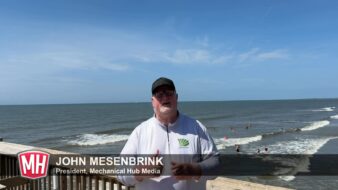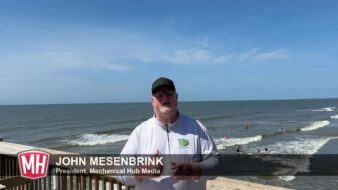By Rich Grimes
Please explain a “cold water sandwich” and what causes this to happen?
A cold water sandwich can occur on tankless water heaters when the system keeps drawing hot water, but the heater cycles off and then back on again, after a time delay. This does not occur with every tankless model, but it is relative to water pressure change, typically triggered by a single-handle faucet or shower valve.
Some manufacturers sense only flow rate and do not use any time delay. These heaters are sensing a minimum flow rate (typically .5 gpm to activate) and will shut the burner down if the flow rate falls below .4 gpm. Once a flow rate of .5 gpm is reestablished, the heater will immediately restart. Heaters that sense only flow rate do not produce cold water sand- wiches.
The heaters that tend to experience cold water sandwiches sense flow, but they also sense pressure. When a single-han- dle faucet is adjusted from full hot and then back to center (mixed hot and cold), the heater senses the pressure drop and can cut the burner out. Before the heater will restart, there is a delay of 15 to 25 seconds before the burner fires. The result is someone taking a shower with steady hot water flowing. If they make enough of an adjustment on the shower valve, the burn- er cuts off and restarts in approximately 15 seconds. So what happens is steady hot water is followed by a 15-second slug of cold water and then followed by hot water again. It will get your attention if you experience it!
In summary, flow-only sensitive heaters do not have any delays in re-ignition and do not create cold water sandwich effects. Heaters that are flow and pressure sensitive can create a cold water sandwich in certain conditions, but not always. A two-handle faucet does not mix within a single cartridge like a pressure-balancing valve and therefore has zero effect on a heater that is flow and pressure sensitive.
What are the requirements for ASME construction in the State of Florida?
The ASME boiler code calls for ASME construction of water heaters, boilers, storage tanks, and expansion tanks if one or more of the following conditions apply:
1) Any unit that is rated at 400,000 Btu or more (gas fired)
2) Any unit that is rated at 120 gallons or more
3) Any unit that is rated over 58 kW Input (electric fired)
Most states use 200,000 Btu as their threshold for ASME, but Florida is higher at 400,000 Btu. You get an understanding why there are many units rated at 199,999 or 399,999 Btu or 119 gallons or 54 kW maximum.
I am confused by inspectors who call for conformance with the Florida boiler dode when my heater is rated at 300,000 Btu with 65 gallons of storage. Doesn’t my heater fall below the ASME requirements of the State of Florida?
Your heater does fall below the ASME requirements, but the inspector is referring to the boiler room itself, not the water heater. The heater does not have to be ASME constructed. However, the Florida boiler code calls for a two-hour fire-rated mechanical room with sealed, fire-stopped penetrations on units of 250,000 Btu or more. It can be tricky to figure out sometimes, but it is always best to ask for code interpretation from your inspector prior to final installation.
I have a high-efficiency heater that vents with plastic piping due to its low exhaust temperature. My installation requires the vent piping to run through a return air plenum. Can I use plastic piping such as PVC or CPVC?
No, not in this application. Many high-efficiency, gas-fired units can be vented with a sealed plastic vent system. Most manufacturers specify either PVC, CPVC or ABS as an ap- proved vent material.
Any plastic piping that runs through return air plenums must be water-filled or specifically rated for use in return air plenums. In these instances, it is recommended to use a metallic vent material such as AL29-4C stainless steel in plenum areas. It is approved as a sealed Category IV vent system and can transi- tion to and from plastic piping. Another alternative is to use a metallic sleeve, but that can be cost prohibitive and require larg- er penetrations, firestopping, etc.
Many heater controls, like flow switches and pressure switches, have multiple electrical contacts. Please explain the COMMON, NO and NC contacts on these controls.
An internal switch will turn the control on and off based on flow, pressure, temperature, etc. A switch has a normal position of either open or closed. When activated, the switch will per- form its specific duty to open or close a circuit.
• The COMMON contact is where incoming power enters the device and is connected to this contact.
• The NC contact is the normally closed contact. It has power already from the COMMON, but will lose power once the switch is made.
• The NO contact is the normally open contact. It is an open cir- cuit that receives power once the switch is made.
We will use a flow switch as an example. The flow switch is a normally open device that closes (switches) upon flow. When flow reaches a set, minimum flow rate, the power is switched from the NC contact to the NO contact. So, if wired to the NC contact, the power is lost upon switch activation. If wired to the NO contact, power is gained upon switch activation.
A pressure switch may be a normally closed switch or a nor- mally open switch depending on its service. An air-intake switch is likely to be an NC device allowing power across its cir- cuit, but if the intake gets closed off, the switch will open and not allow power to pass through. A fan prover switch is likely an NO device that completes its circuit once the fan has reached a certain speed or CFM, proving proper combustion fan opera- tion.
There is a document you can download that will give a great- er description of diaphragm switches and how they operate at: http://www.statewaterheaters.com/lit/handbooks/320988-000.pdf.
Why are there multiple high limits and other additional controls on many heaters and boilers?
Depending on its Btu rating, certain controls are required for safety. As a unit exceeds the ASME requirement, more controls are required to meet the ASME standard. For instance, in Flor- ida HLW-stamped boilers are required to have a low water cut- off device (LWCO) and manual reset high limit (MRHL). H- stamped boilers may require additional high and low gas pres- sure switches. Each state’s boiler inspectors have different re- quirements to meet their code. Some will require a float-type LWCO where others will accept a probe-type. A flow switch is an acceptable form of a LWCO on a circulating boiler/water heater in Florida.
There are also special insurance requirements like FM (fac- tory mutual) and IRI (individual risk insurers) that have addi- tional controls they will require. Most insurers accept manufac- turer’s standard controls on units under 400,000 Btu with addi- tional controls added on larger models. Depending on a unit’s approval by CSA, UL, ETL, etc., they will dictate the standard controls. Controls requirements increase with higher Btu in- puts, as set forth by the approving agency.
It is very common to see a couple of high limit controls. One is typically auto-reset and another is manual reset. These con- trols are wired in series with the operating thermostat. The high limit controls are designed to prevent over-temperature by shutting off the boiler. The auto reset control will reset itself once the temperature has been lowered to a safe condition. The manual reset is set a little higher than the auto reset and has the same function. However, if the manual reset is tripped on temperature, it requires someone to physically reset it.




Join the conversation: